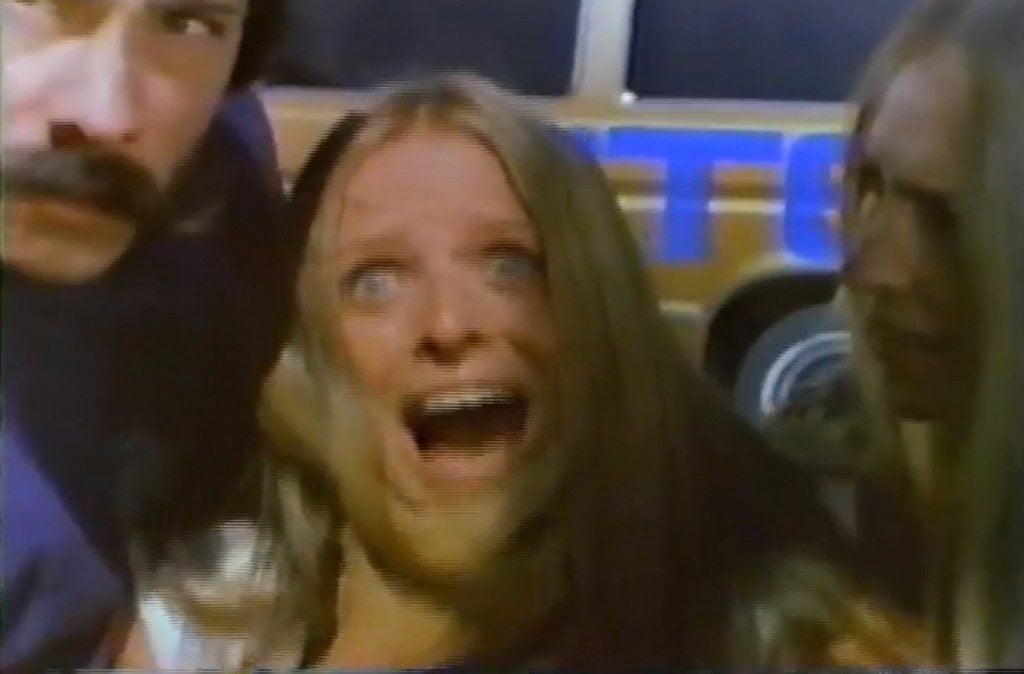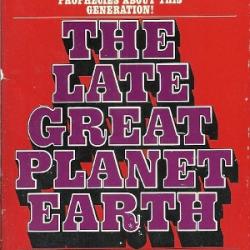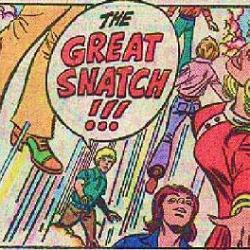Today at Religion & Politics, Amy Frykholm considers “The 40th Anniversary of A Thief in the Night.”
Donald W. Thompson’s low-budget premillennial dispensationalist horror movie is a haunting classic for many of us who grew up in evangelical and fundamentalist churches. It’s also a direct ancestor of the Left Behind novels, which took their title from the Larry Norman song sung by a groovy combo in the opening credits of A Thief in the Night.
http://www.youtube.com/watch?v=UPBQsOxHX4gLife was filled with guns and war,
And everyone got trampled on the floor,
I wish we’d all been ready
Children died, the days grew cold,
A piece of bread could buy a bag of gold,
I wish we’d all been ready,
There’s no time to change your mind,
The Son has come and you’ve been left behind.
(Here’s Larry Norman’s version of the song. The full movie of A Thief in the Night is also on YouTube.)
I’m a bit too brain-fried and bone-weary at the end of a long week to spend time today with the likes of Rayford Steele and Buck Williams, so instead let’s revisit this related classic with Frykholm. She knows this world, having immersed herself in PMD prophecy-mania while writing Rapture Culture: Left Behind in Evangelical America, which takes an empathetic and generous look at some of the tens of millions of fans of the World’s Worst Books.
It’s jarring to realize this movie is 40 years old — another reminder that I’m getting older myself. But it must be particularly strange for the filmmakers themselves. They were absolutely certain, back when they made this movie, that the world was going to end long before 40 years had gone by. (Specifically, their splicing and twisting of several disparate verses in the Bible had them convinced the world had only a single “generation” after 1948.)
Here’s Frykholm on A Thief in the Night at 40:
A Thief in the Night is a cult classic, where the word “cult” has more than one resonance. If you have seen it, the setting was likely a church basement, a church camp, or some other quasi-authoritative space where the film’s sermonizing might have been accompanied by an earnest youth pastor worried for your soul. The film was released in 1972 and marks its 40th anniversary this year. It has influenced a generation of Christians reared in the 1970s and ’80s. To date, the movie has been seen by perhaps more than 50 million people worldwide; others estimate as high as 300 million. (Because viewing and distribution has largely been through alternative mechanisms, an accurate accounting is impossible.) “Today, many teen evangelicals have not seen A Thief in the Night, but virtually every evangelical over 30 I’ve talked to is familiar with it, and most have seen it,” writes Heather Hendershot in her book Shaking the World for Jesus.
… The film had an enormous impact on evangelical culture and shaped its attempts to influence American popular culture more directly through music, film, and books. … This film inspired people from across the political and social spectrum. Marilyn Manson, who like so many saw the film at church as a child, wrote in his autobiography The Long Road Out of Hell, “I was thoroughly terrified by the idea of the end of the world and the Antichrist. So I became obsessed with it, watching movies like … A Thief in the Night, which described very graphically people getting their heads cut off because they hadn’t received 666 tattoos on their forehead.”
… All of this might just be a low-budget, poorly-acted, B-grade movie long since constrained to the dust bin of film history. But when the film came out in 1972, the evangelical establishment was in the midst of an extraordinary expansion that included inroads into mainstream radio, publishing, and television. According to film historian Terry Lindvall, the makers of A Thief in the Night were helped by the fact that after World War II, the U.S. Army donated film projector equipment to churches and schools. The capacity to show the film through this network was already in place. Lindvall points out that A Thief in the Night was one of the only films available to young people coming from fundamentalist backgrounds who “were not allowed to go to movies to even see The Sound of Music.” When an organization called the Christian Film Distributors Association started in 1974, they stocked copies of the film and saw bookings of 1500 showings a month, mostly at Baptist churches and schools and youth retreats. Halloween, Lindvall notes, was a popular time for viewing. “It was the filmmakers’ goal to ‘literally scare the hell out of kids.’”
Religious historian Randall Balmer grew up in Thompson’s church and profiled him fondly in a chapter of Balmer’s book Mine Eyes Have Seen the Glory. Balmer also highlights this “literally scare the hell out of kids” aspect of these movies:
If the plot is a bit obvious in places, it’s also quite compelling, especially when shown in an evangelical setting to people reared to take the apocalyptic passages of the Bible literally. …
The success of any movie invites sequels, and Thompson has obliged. A Distant Thunder, Image of the Beast, and Prodigal Planet all depict life on earth after the rapture, after true Christians, the born-again believers, have ascended into heaven. The producers tout these films as a kind of pre-history — “a true story that is yet to happen” — portraying the brutality of existence during the tribulation prophesied in Revelation. Indeed, much of this is gruesome, replete with radiation sickness, blood-curdling screams, increased repression by UNITE [Thompson’s version of the Antichrist’s OWG], and stainless steel guillotines. The events of the book of Revelation “could become a reality in your lifetime,” the films warn. “Avoid these events by coming to Christ now.”
The guillotines I remember. I remember watching the guillotine scene (in A Distant Thunder) in the youth room of our church. I knew I was already born-again and saved by my personal savior Jesus Christ, but I still “went forward” at the altar call afterward to re-re-re-dedicate my life to Christ, just to be sure. And then I still had nightmares, plus the occasional moment of panic when it seemed I was suddenly alone in my house or at church.
Balmer examines this scare-’em-into-heaven approach of the movie:
Doesn’t all this have the effect of frightening people into the kingdom of heaven? In the midst of her miseries in A Distant Thunder, Patty [the protagonist, played by amateur actress Patty Dunning] answers for the producers: “I would rather have been scared into heaven than have to go through this.” I put the question to [producer Russell] Doughten. … His initial response was that “if they get into the kingdom through being scared, that’s better than not making it at all.” He continued: “… All we’ve tried to do in the films is to put these things revealed in the Scripture into a dramatic setting. We’re just trying to illustrate what’s there. If it frightens you, then maybe it’s your problem, because from our point of view that’s what the Lord is telling you.”
Here we encounter another theological chicken-and-egg question: Does this dismally stunted soteriology stem from the warped eschatology of PMD prophecy nonsense, or vice versa?
I’ve often contrasted this urgent proselytizing with the triumphalism of the Left Behind series. I was looking back at some of the places where we’ve discussed A Thief in the Night previously, and it seems I’ve repeated that point enough times not to repeat it too much here again. Some examples:
- LB: The Hypothetical Bus (2003)
- LB: Faith vs. Reason (2006)
- TF: How Not To Do Evangelism (2011)
- TFTM: Return of Angelic Woman (2012)
On this point, I think Frykholm’s emphasis on Thief as a horror movie is insightful. Thompson wrote horror. LaHaye and Jenkins think of themselves as writing thrillers.
Anyway, back to Amy Frykholm:
A Thief in the Night emerged at a moment when American evangelicalism was ripe to receive it. Its effective play on cultural and psychological fears paradoxically helped set the stage for conservative evangelicalism to imagine itself as a more significant part of American culture. [Religion scholar John] Walliss notes that the film diagnosed evangelicals’ concerns about the direction of American culture: the technological, social, and political ills that they believed signified the beginning of the end times. That diagnosis did not create an isolating inward turn, but instead became part of a movement toward greater political engagement. We can see that shift even in the Mark IV films themselves. In the first film, the emphasis is very much on personal and individual salvation, but by the fourth film, political engagement and fighting with the Antichrist is more central. This is true in the Left Behind series as well, as the Tribulation Force draws on ever-more sophisticated means to battle for Christianity even in the End Times. This movement mirrored the political direction of Christian evangelicalism, which entered the 1970s as largely nonpolitical and exited as an energized voting bloc that had begun to claim the label “Moral Majority.” We feel the resonances of this politicization of conservative evangelicals to this day.
… In Paula Booke’s view, Christian evangelical political engagement is an actual outgrowth of the earlier apocalypticism. Images like UNITE — a reflection of the era’s concerns about communism—were effective in creating a “common script” that evangelicals could share. The film offered a subtle narrative critique of the political world that the viewers inhabited and then shaped both the faith they claimed and their political views. The apocalyptic narrative has proved itself “malleable to the political contexts of the present moment,” Booke says. “I have a suspicion, and I am trying to think how to demonstrate it, that most Americans are latent premillennialists and that it shapes their political views in subtle ways.”
Booke, Frykholm says, is a political scientist “who wrote her doctoral dissertation at the University of Chicago on the influence of premillennial eschatology on American politics.” I suspect she is onto something with that idea of “latent” premillennialism. The exotic mythology of these weird eschatologies pervade our popular culture, so that even people who don’t embrace Tim LaHaye’s theology have ingested the broad outlines of his ideology. Even people who have never set foot in a prophecy-obsessed church will make jokes about the rapture or the Antichrist.
The premillennial influence on American politics was most evident in the early 20th century, when evangelicals began withdrawing from public life — from politics, culture, academia, everything — at the same time that Scofield’s footnotes were making PMD eschatology ever-more popular. The logic of that seems clear. Premillennialism says that the world is getting worse and worse, and will keep on getting worse and worse until Jesus comes back. And there’s nothing any of us can do to change that. That pessimism or fatalism makes political engagement seem futile.
And yet many premillennialist prophecy types do get engaged in politics — think of Tim LaHaye himself, or of one-time Secretary of the Interior James Watt, who said, regarding environmental management, “I do not know how many future generations we can count on before the Lord returns.” Or more recently, right-wing blogger Erick Erickson inadvertently created a meme last month when he reacted to an Obama campaign ad by tweeting, “We do live in a fallen, depraved world destined for the fire.”
I suspect the main way that premillennial pessimism influences American politics is in the way it portrays human history as an inexorably downward slope, a widening gyre spiraling ever downwards from the Golden Age of the past to the inevitable chaos and lawlessness of the End Times. A progressive vision of politics isn’t likely for those who view progress as a theological impossibility. It’s not surprising that Erickson didn’t like Obama’s campaign. A candidate who speaks of hope and change isn’t going to appeal to someone whose eschatology insists that hope and change are nothing more than illusions “in a fallen, depraved world destined for the fire.”













